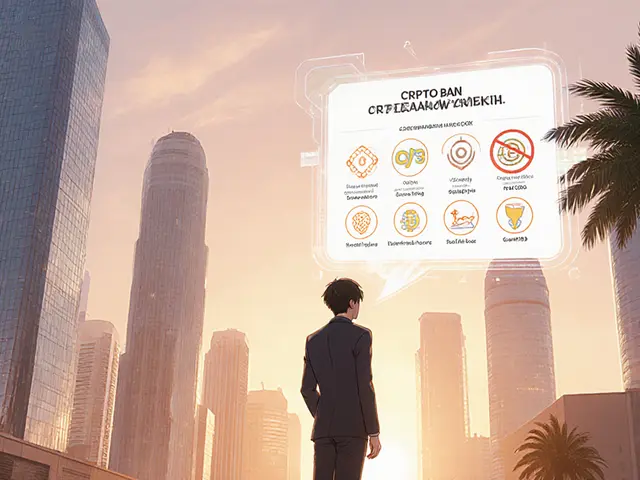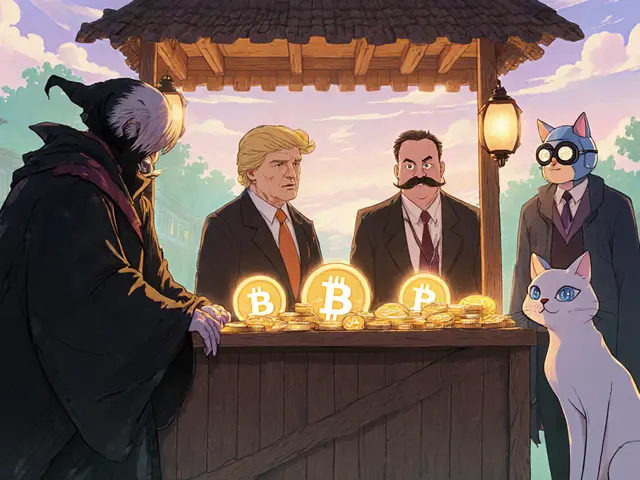27
Understanding Qatar’s Institutional Crypto Ban and Its Impact on the Financial Sector

Qatar Crypto Ban Compliance Checker
Select the type of financial activity you're considering in Qatar to check if it's permitted under the current regulatory framework:
Legal Basis:
Key Takeaways
- Qatar cryptocurrency ban prohibits all financial institutions from handling crypto, stablecoins or CBDCs.
- Qatar Central Bank (QCB) issued Circular No.6 in 2018, forming the legal backbone of the ban.
- The 2024 QFC Digital Assets Regulations open a narrow gateway for tokenized securities but keep crypto excluded.
- Penalties include license revocation, heavy fines, and increased compliance costs for multinational firms.
- Compared with the UAE and Bahrain, Qatar remains the most restrictive GCC jurisdiction on institutional crypto activity.
Qatar has carved a very conservative path when it comes to digital currencies. While many Gulf states are building sandbox environments for crypto firms, Qatar’s financial regulators have erected a solid wall around the sector. The result? A comprehensive institutional ban that stops banks, investment houses, and other licensed entities from touching any cryptocurrency, stablecoin, or central bank digital currency (CBDC). At the same time, the Qatar Financial Centre (QFC) is testing a controlled framework for tokenized traditional assets. This article walks you through the legal timeline, the exact scope of the prohibition, enforcement practices, and what the future might hold for fintech innovators eyeing the Doha market.
Regulatory Background: From Circular No.6 to the 2019 Alert
In February 2018, the Qatar Central Bank (QCB) released Circular No.6. The directive explicitly barred all licensed financial institutions from facilitating Bitcoin or any other virtual‑currency transaction. Two years later, the Qatar Financial Centre Regulatory Authority (QFCRA) reinforced the stance with a December26,2019 alert that defined "virtual assets" as digital substitutes for currency used for trading, transfer, or payment. The alert made it clear that traditional fiat currencies were excluded from this definition, but every form of crypto‑like token fell under the ban.
Scope of the Institutional Ban
The 2019 QFCRA alert enumerated four core prohibitions that still apply today:
- Exchanging virtual assets for fiat currency.
- Transferring or safekeeping virtual assets on behalf of clients.
- Providing any financial service related to the issuance of virtual assets.
- Offering custodial, advisory, or brokerage services for crypto‑related products.
These rules cover not only well‑known cryptocurrencies such as Bitcoin and Ethereum, but also stablecoins, and central bank digital currencies (CBDCs). In Qatar’s regulatory lexicon, all of these are classed as “Excluded Tokens.” The ban therefore blocks any institutional exposure to price‑volatile digital assets, regardless of whether the token is used for payment, store of value, or speculative trading.
2024 Digital Assets Regulations: A Controlled Opening
On September1,2024, the QFC introduced the Digital Assets Regulations. While the headline claim was “digital‑asset friendly,” the fine print shows a narrow focus on tokenized versions of traditional securities - shares, bonds, sukuk, commodities, and real‑estate. The framework provides a clear validation, registration, and custody process, aiming to inspire confidence among institutional investors.
The regulations explicitly reiterate that the previously banned virtual assets remain “Excluded Tokens,” ensuring that the core institutional crypto ban stays intact. In practical terms, a Doha‑based bank may now offer custody for a tokenized sovereign bond, but it cannot open a crypto‑trading desk or hold Bitcoin for a client.

Enforcement and Compliance Mechanisms
Compliance is monitored through regular reporting to the QCB and QFCRA. Financial institutions must embed the ban into their internal policies, risk‑assessment tools, and client onboarding procedures. Failure to comply can trigger:
- Heavy monetary penalties (often exceedingUSD1million per breach).
- Suspension or revocation of banking licences.
- Public censure and inclusion on a regulator‑maintained blacklist, which hampers the firm’s ability to operate across the GCC.
Because the ban is institution‑wide, multinational banks operating in Qatar must maintain a separate, crypto‑free operating model for all Qatar‑licensed entities, even if they offer crypto services in the UAE or Bahrain.
How Qatar’s Ban Stacks Up Against Its Neighbours
| Country | Regulatory Approach | Key Provisions |
|---|---|---|
| Qatar | Full institutional ban | Prohibits all crypto, stablecoins, CBDCs; tokenized securities allowed under 2024 framework. |
| Kuwait | Comprehensive ban | July2023 circular bars crypto payments, investments, mining; similar to Qatar. |
| United Arab Emirates | Permissive sandbox | DFSA and ADGM license crypto exchanges, custodians, and tokenized asset platforms. |
| Bahrain | d>Progressive regulation | CMC enables crypto‑service providers, with AML/KYC standards. |
| Saudi Arabia | Mixed stance | Focus on wholesale CBDC for interbank settlement; retail crypto remains restricted. |
Market Implications and Practical Realities
For investors, the ban creates a clear “no‑go” zone. Institutional capital that might have otherwise been deployed into crypto funds is redirected toward traditional assets or the emerging tokenized‑securities market. This limits regional liquidity and reduces Qatar’s influence on global crypto price formation.
For fintech firms, the regulatory landscape demands a dual‑track strategy: develop crypto‑related products for the UAE/Bahrain while engineering a compliant, crypto‑free version for Qatar. Legal teams often need separate contracts, KYC flows, and data‑segregation architectures to satisfy QFCRA reporting requirements.
Despite the restriction, the tokenized‑asset framework opens a niche corridor. Early adopters can issue blockchain‑based sukuk, gaining faster settlement times and broader investor reach, all while staying within the QFC’s legal envelope.
Future Outlook: Will the Ban Ever Ease?
Analysts expect the core institutional ban to stay firm through at least 2026. The QFC’s digital‑assets workgroup is slated to finalize a list of approved token types by Q22025, but all indications point to crypto‑type tokens remaining excluded. External pressure may rise if the UAE’s crypto ecosystem delivers measurable economic benefits without destabilising its financial system. Still, Qatar’s emphasis on sovereign monetary control and the alignment with its National Vision2030 suggest a continued preference for cautious, token‑based innovation rather than open‑ended crypto markets.
Frequently Asked Questions
Does the ban apply to private individuals in Qatar?
The ban specifically targets licensed financial institutions. Private individuals can still hold crypto on personal wallets, but banks cannot facilitate purchases, custody, or transfers on their behalf.
Can foreign crypto exchanges operate in Qatar?
No. Any entity that wishes to offer crypto services to Qatar‑based clients must obtain a local financial licence, which automatically subjects it to the institutional ban.
What types of tokenized assets are permitted under the 2024 regulations?
Tokenized shares, bonds, sukuk, commodities, and real‑estate are allowed, provided they are registered with the QFC and meet the custody standards set out in the Digital Assets Regulations.
What are the penalties for violating the crypto ban?
Violations can lead to fines exceedingUSD1million, suspension of the offending institution’s licence, and possible criminal prosecution for senior compliance officers.
Is there any chance the ban will be lifted in the near future?
Current government statements and the strategic alignment with Qatar National Vision2030 suggest the ban will remain in place for the foreseeable future, though the tokenized‑asset framework may expand.









Jacob Anderson
November 27, 2024 AT 03:15Wow, another deep dive into Qatar’s love‑hate relationship with crypto. Clearly the regulators just enjoy watching fintech startups choke on paperwork while they sip their karak tea. It’s almost adorable how they lump stablecoins with CBDCs like a toddler mixing Lego blocks. Guess the only thing they’re really banning is innovation.
Kate Nicholls
November 27, 2024 AT 04:13Honestly, the ban reads like a textbook example of regulatory overreach. While other GCC states flirt with tokenization, Qatar seems determined to preserve the status quo at all costs. Their blanket prohibition will only push talent out of Doha.
Carl Robertson
November 27, 2024 AT 05:36The drama surrounding Qatar’s crypto policy could fill an entire season of a legal thriller. First, we had Circular No.6 in 2018, a quiet yet ominous decree that warned banks away from Bitcoin like a scared cat. Then the 2019 QFCRA alert arrived, brandishing the term “Excluded Tokens” as if it were a magical shield against any digital asset. Fast‑forward to 2024, and the QFC tries to be the hero by opening a door for tokenized securities, only to slam it shut for every other crypto‑like instrument. It’s as if the regulators enjoy playing whack‑a‑mole with fintech innovators, poking holes in every new idea that dares appear. The penalties, exceeding $1 million per breach, feel less like deterrence and more like a threat to bankrupt any institution brave enough to test the limits. Meanwhile, multinational banks must maintain two parallel operating models, a crypto‑free version for Qatar and a permissive one for the UAE, creating needless complexity. The enforcement machinery is also impressive: mandatory reporting, internal policy rewrites, and a public blacklist that could tarnish a firm’s reputation across the entire GCC. One could argue that this strict stance protects monetary sovereignty, but at what cost? The opportunity cost is massive – capital that could flow into Doha’s burgeoning fintech scene is diverted elsewhere, and the region loses out on potential liquidity and innovation. Furthermore, the tokenized‑securities gateway, while promising, remains a narrow corridor, barely enough to sustain a vibrant digital‑asset ecosystem. In short, Qatar’s approach is a masterclass in regulatory caution, but it also serves as a cautionary tale of how fear can stifle progress.
Rajini N
November 27, 2024 AT 07:00To add some context, the 2024 Digital Assets Regulations specifically carve out an exemption for tokenized traditional assets such as sukuk, bonds, and equities. This means that a Doha‑based bank can legally provide custody and settlement services for a blockchain‑based sukuk, provided it registers the token with the QFC and complies with the stipulated custody standards. However, the same regulations reinforce that all “Excluded Tokens” – which include Bitcoin, Ethereum, stablecoins, and any CBDC prototypes – remain prohibited for institutional use. In practice, firms should update their AML/KYC frameworks to flag any transaction involving these excluded tokens and ensure that their internal risk models treat them as non‑permissible. A practical way to stay compliant is to segregate client onboarding flows: one path for tokenized securities, another for traditional fiat services, and a hard stop for any crypto‑related request.
Sidharth Praveen
November 27, 2024 AT 08:23Even with such a restrictive environment, there’s still room for optimism. The tokenized securities niche can become a launchpad for Qatar to showcase blockchain’s efficiency without compromising its risk appetite. By focusing on high‑value assets like sukuk, the market can attract institutional investors who value both compliance and speed.
Sophie Sturdevant
November 27, 2024 AT 09:46From a compliance‑technology standpoint, the key performance indicators (KPIs) for monitoring excluded token activity revolve around transaction monitoring alerts, AML rule‑sets, and real‑time blockchain analytics. Leveraging tools such as chain‑risk scoring and address‑watchlists can automate the detection of prohibited crypto flows, ensuring that the institution stays within the regulatory perimeter while maintaining operational efficiency.
Nathan Blades
November 27, 2024 AT 11:10Think of the regulatory landscape as a river – sometimes it’s calm, sometimes it’s a rapid. Qatar’s current rapids may seem unforgiving, but they can also carve a deeper channel for innovation in tokenized assets. Embrace the challenge, and you’ll find that the most resilient fintech solutions arise from navigating these turbulent waters.
Somesh Nikam
November 27, 2024 AT 12:33Totally get the frustration, but there’s a silver lining! By mastering the tokenized‑securities framework now, you’ll be ahead of the curve when the region eventually relaxes its stance. Keep pushing, and remember: every hurdle is just a stepping stone. :)
Jan B.
November 27, 2024 AT 13:56Interesting take.
MARLIN RIVERA
November 27, 2024 AT 15:20This post ignores the fundamental flaw: banning technology doesn’t make it disappear. It only drives it underground where oversight is zero, increasing systemic risk. The blanket prohibition is a naive solution to a complex problem.
Debby Haime
November 27, 2024 AT 16:43Let's channel that energy into constructive action! The tokenized‑asset space is ripe for growth, and with the right partnerships, Doha can become a hub for compliant blockchain finance. Keep the momentum going!
emmanuel omari
November 27, 2024 AT 18:06As someone who knows the Middle Eastern financial landscape inside out, I can tell you that Qatar’s approach is simply a reflection of its sovereign priorities. It’s not about being anti‑innovation; it’s about protecting national monetary integrity. Anyone who blames the ban for stifling growth is ignoring the bigger picture of regional stability.
Andy Cox
November 27, 2024 AT 19:30Just watching the discussion unfold feels like observing a cultural exchange – each perspective adds a layer to the overall understanding of how regulation and tech intersect in the Gulf.